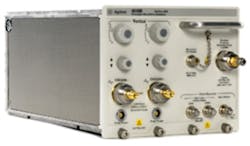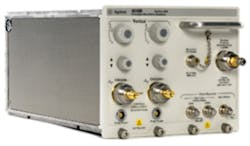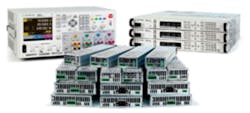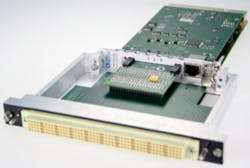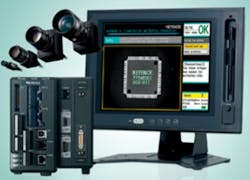Scope Module for 10- to 32-Gb/s Designs
Continuous data-rate coverage from 50 Mb/s to 32 Gb/s, peaking control, and adjustable loop bandwidths to 20 MHz also allow the clock recovery circuit to provide a golden PLL response for compliant device characterization. An integrated instrumentation-grade clock recovery circuit enables the module to trigger directly from single-ended or differential data signals, eliminating the need for a separate trigger input. The module also integrates high-bandwidth pickoffs and phase-matched cables, which reduce setup complexity and maintain signal integrity. From $80,000.
RF Signal Generators
High-Power Modules
40-GHz Bandwidth Socket
The socket connects all pins with 40-GHz bandwidth and mounts on the target PCB with no soldering. It is constructed with a shoulder screw and a swivel lid that incorporates a quick insertion method so ICs can be changed out quickly. The temperature range is -55°C to +150°C. The pin self-inductance is 0.10 nH, and mutual inductance is 0.007 nH. Capacitance to ground is 0.069 pF. Current capacity is 4 A per pin. From $1,727 for a quantity of one.
JTAG Hardware for Mass-Interconnect System
The new module is available in two versions. As an option for the SFX/PXI1149/Cx-FXT and SFX/PXIe1149/Cx-FXT controller, the PXI 1149/DAK2 has a differential test bus with a 200-pin receiver and single-ended PIP resources. The PXI 1149/DAK1 has a single-ended test bus with a 96-pin receiver as well as single-ended PIP resources and is an option for the SFX/PXI1149/Cx and SFX/PXIe1149/Cx controller. Each mass-interconnect interface also is available as a variant supporting the PXI 1149/DAK-E1 and PXI 1149/DAK-E2 Direct Access Kit-Extended versions.
Embedded Vision System
The EOS-1200 features four serial ports, two USB 3.0 ports, 32 PNP/NPN isolated digital I/Os, two SATA interfaces, and one CFAST slot. Driver support is provided for Windows 7/XP and Embedded standard 7 in both 32-bit and 64-bit versions. From $1,885.
Vision System With Line-Scan Cameras
Visual LED indicators built into the company’s line-scan cameras display received-light intensities and image sharpness, simplifying the normally difficult and time-consuming setup process. A new human-machine interface touch panel is optional.
Web-Based Sensor System
The wireless system complies with IEEE 802.15.4 operating at 2.4 GHz. No special software is required, and the device can trigger an alarm if variables go above or below a user-determined set point. A selection of end devices accommodates a variety of applications. Each device supports one or two sensors, and the devices are available with built-in sensors, external sensor probes, and both built-in and external sensors.
